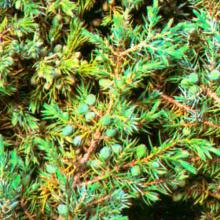Juniperus communis
Common name:
Common juniper
Genus:
Juniperus
Family:
Cupressaceae
Order:
Pinidae
Juniperus communis
Common name:
Common juniper
Genus:
Juniperus
Family:
Cupressaceae
Order:
Pinidae
Juniperus communis
Common name:
Common juniper
Genus:
Juniperus
Family:
Cupressaceae
Order:
Pinidae
Genus (Platae): Juniperus
Junipers are coniferous trees and shrubs in the genus Juniperus /dʒuːˈnɪpərəs/ of the cypress family Cupressaceae. Depending on taxonomic viewpoint, between 50 and 67 species of junipers are widely distributed throughout the Northern Hemisphere, from the Arctic, south to tropical Africa, from Ziarat, Pakistan, east to eastern Tibet in the Old World, and in the mountains of Central America. The highest-known juniper forest occurs at an altitude of 16,000 ft (4,900 m) in southeastern Tibet and the northern Himalayas, creating one of the highest tree-lines on earth.
Description
Junipers vary in size and shape from tall trees, 20–40 m (66–131 ft) tall, to columnar or low-spreading shrubs with long, trailing branches. They are evergreen with needle-like and/or scale-like leaves. They can be either monoecious or dioecious. The female seed cones are very distinctive, with fleshy, fruit-like coalescing scales which fuse together to form a "berry"-like structure, 4–27 mm (0.16–1.06 in) long, with one to 12 unwinged, hard-shelled seeds. In some species, these "berries" are red-brown or orange, but in most they are blue; they are often aromatic and can be used as a spice. The seed maturation time varies between species from 6 to 18 months after pollination. The male cones are similar to those of other Cupressaceae, with six to 20 scales.
In zones 7 through 10, junipers can bloom and release pollen several times each year. A few species of junipers bloom in autumn, while most species pollinate from early winter until late spring.
Many junipers (e.g. J. chinensis, J. virginiana) have two types of leaves; seedlings and some twigs of older trees have needle-like leaves 5–25 mm (0.20–0.98 in) long, and the leaves on mature plants are (mostly) tiny (2–4 mm (0.079–0.157 in)), overlapping, and scale-like. When juvenile foliage occurs on mature plants, it is most often found on shaded shoots, with adult foliage in full sunlight. Leaves on fast-growing 'whip' shoots are often intermediate between juvenile and adult.
In some species (e.g. J. communis, J. squamata), all the foliage is of the juvenile needle-like type, with no scale leaves. In some of these (e.g. J. communis), the needles are jointed at the base, while in others (e.g. J. squamata) the needles merge smoothly with the stem.
The needle-leaves of junipers are hard and sharp, making the juvenile foliage very prickly to handle. This can be a valuable identification feature in seedlings, as the otherwise very similar juvenile foliage of cypresses (Cupressus, Chamaecyparis) and other related genera is soft and not prickly.
Juniper is the exclusive food plant of the larvae of some moths and butterflies, including Bucculatrix inusitata, juniper carpet, Chionodes electella, Chionodes viduella, juniper pug, and pine beauty. Those of the tortrix moth Cydia duplicana feed on the bark around injuries or canker.
Junipers are gymnosperms, which means they have seeds, but no flowers or fruits. Depending on the species, the seeds they produce take 1–3 years to develop. The impermeable coat of the seed keeps water from getting in and protects the embryo when being dispersed. It can also result in a long dormancy that is usually broken by physically damaging the seed coat. Dispersal can occur from being swallowed whole by frugivores and mammals. The resistance of the seed coat allows it to be passed down through the digestive system and out without being destroyed along the way. These seeds last a long time, as they can be dispersed long distances over the course of a few years.
Reference: Wikipedia

